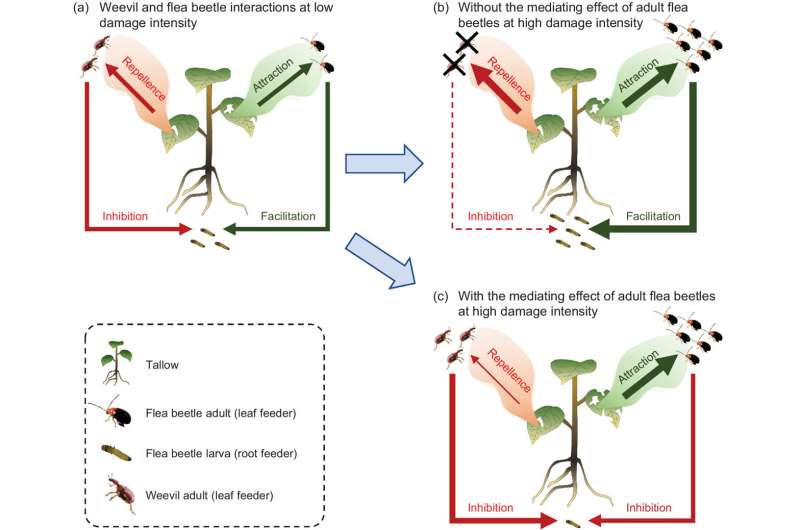Herbivore identity and density interact to determine plant-mediated interactions between herbivores

Plants are often exposed to multiple herbivores, and densities of these attackers often fluctuate greatly in the field. Herbivore identity and density are known to be two major drivers of plant-mediated interactions among herbivores, but their combined effects are poorly understood.
The Invasive Ecology Group from the Wuhan Botanical Garden of the Chinese Academy of Sciences addressed this research gap using Triadica sebifera (tallow), an aggressive woody invader, and two potential biological control agents, Bikasha collaris (flea beetle) and Heterapoderopsis bicallosicollis (weevil).
The researchers investigated how variations in the intensity of leaf damage caused by flea beetle or weevil adults affected the performance of root-feeding flea beetle larvae through manipulation of the density of these two adult herbivores.
They found that weevil leaf damage decreased larval flea beetle survival as leaf damage intensities increased. In contrast, herbivory by adult flea beetles facilitates larval survival at lower feeding intensity, and an effect that was reversed at higher feeding intensity. Furthermore, chemical analysis showed that root primary and secondary metabolism might underlie the observed effects on flea beetle larvae.
This study shows that herbivore identity and density interact to determine systemic plant responses and plant-mediated interactions between herbivores. In particular, plant-mediated effects on herbivore are species-specific at low initial herbivore densities, but converge at high herbivore densities, which is likely to be a common phenomenon among herbivores feeding on the same host plant.
This study, published in Ecology, highlights the consideration of combined effects of herbivore identity and density when identifying factors influencing induced plant responses to herbivory and plant-mediated effects. It will help to further understand the mechanisms that shape the organization and diversity of herbivore communities, providing a new perspective on the improvement of biological control efficiency in future.
More information: Jinlong Wan et al, Species‐specific plant‐mediated effects between herbivores converge at high damage intensity, Ecology (2022). DOI: 10.1002/ecy.3647
Journal information: Ecology
Provided by Chinese Academy of Sciences




















